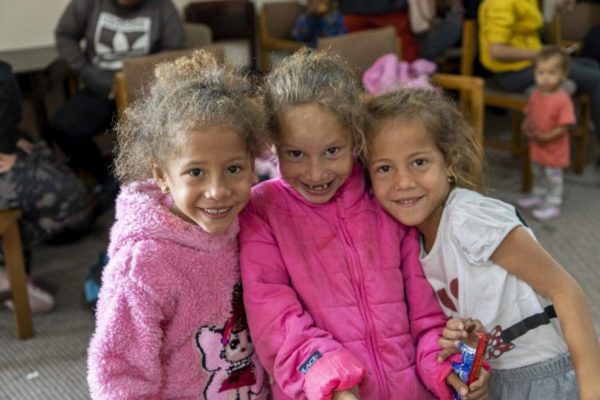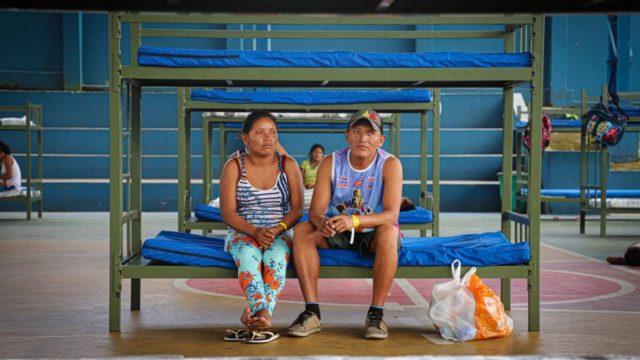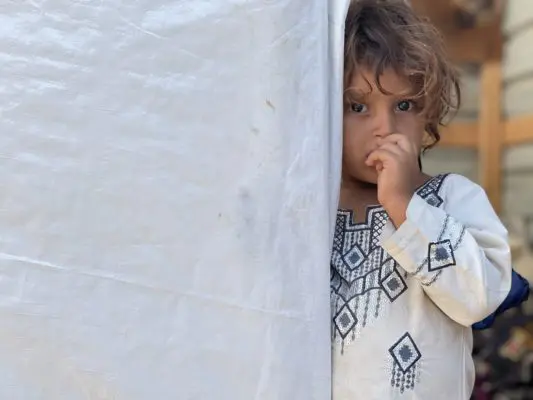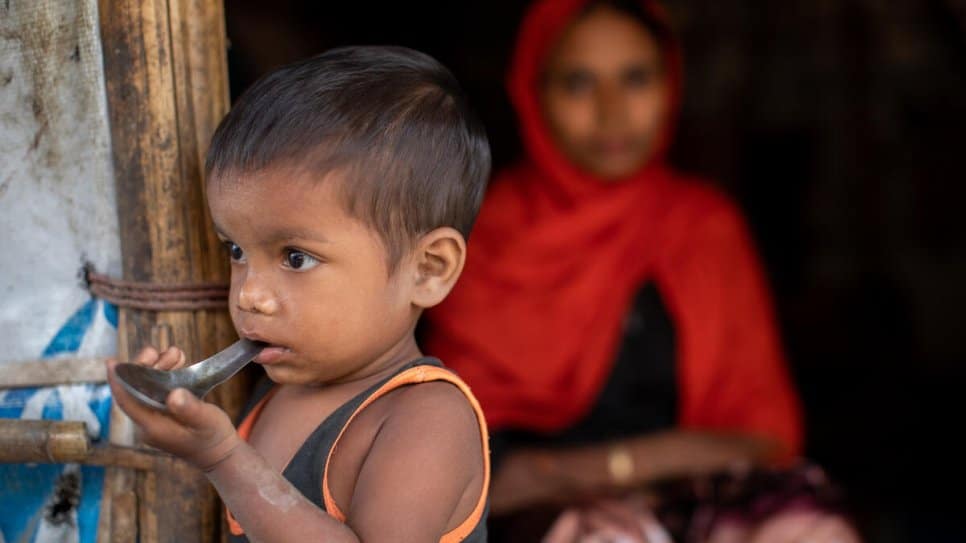
Amid downtowns resulting from coronavirus restrictions, displaced people are particularly vulnerable to food insecurity. © UNHCR/Kamrul Hasan
With COVID-19 lockdowns depriving many of jobs and income, increasing numbers of refugees and asylum-seekers are going hungry.
By Jenny Barchfield
By the time Kimberly Virguez finally took the wrenching choice to leave her native Venezuela, widespread food shortages there had left her 15 kilos lighter. In Peru, where she sought asylum, she quickly put the weight back on.
But then the COVID-19 pandemic struck. Kimberly lost her job, and she and her husband had to start skipping meals to have enough to feed their growing twin boys. After months of eating just once a day, Kimberly again weighs about what she did when she left Venezuela in 2018.
“We’re absolutely desperate.”
“It’s terrible because there’s nothing you can do. The cupboards are empty, but because of the restrictions, you can’t go out there and get a job and earn money for food,” said Kimberly, who lost her job as a chef’s assistant as the virus began its deadly spread through Latin America in March 2020. She was then let go from another position she had briefly held before Peru locked down a second time this January.
“We’re absolutely desperate,” she said.
Situations like Kimberly’s are playing out across the globe, with coronavirus restrictions costing hundreds of millions of jobs worldwide and plunging untold numbers of people into financial freefall. Amid the downturn, displaced people – who are sometimes forced to flee their homes with little more than what they can carry – are particularly vulnerable to food insecurity and malnutrition. After scraping by as best they could for the past year, many now find themselves in dire straits, having to skip meals, line up at soup kitchens or resort to begging or searching for food scraps.
“No country has been spared” the ravages of the coronavirus pandemic, said a recent report by the World Food Programme (WFP) and the International Organization for Migration, examining the close links between global hunger and displacement. The report notes that most displaced people live in urban areas, where the economic impact of COVID-19 has been most pronounced and where they are often the first to lose jobs in times of crisis.
The WFP estimates that as a result of the pandemic, some 270 million people may have been acutely food insecure by the end of 2020. That is around double the 135 million estimated to have been food insecure in 2019 – a record year for hunger. And given that an estimated 80 per cent of displaced people worldwide find themselves in areas affected by high levels of malnutrition and acute food insecurity, the pandemic has made an already desperate situation even worse.
Lockdowns worsen hunger for displaced Afghan families
Putting food on the table has been a struggle for Chinar Gul, 45, ever since 2016, when a rocket hit her home in Kunduz, Afghanistan, killing her husband and forcing her to flee to the capital, Kabul, with her five children. Without her husband, who had been the family’s main breadwinner, Chinar had no choice but to send her 10-year-old son out to collect food that local hotels were discarding.
The family survived on those handouts until the pandemic, when Kabul’s hotels shut down as the city went into lockdown to staunch the spread of the virus.
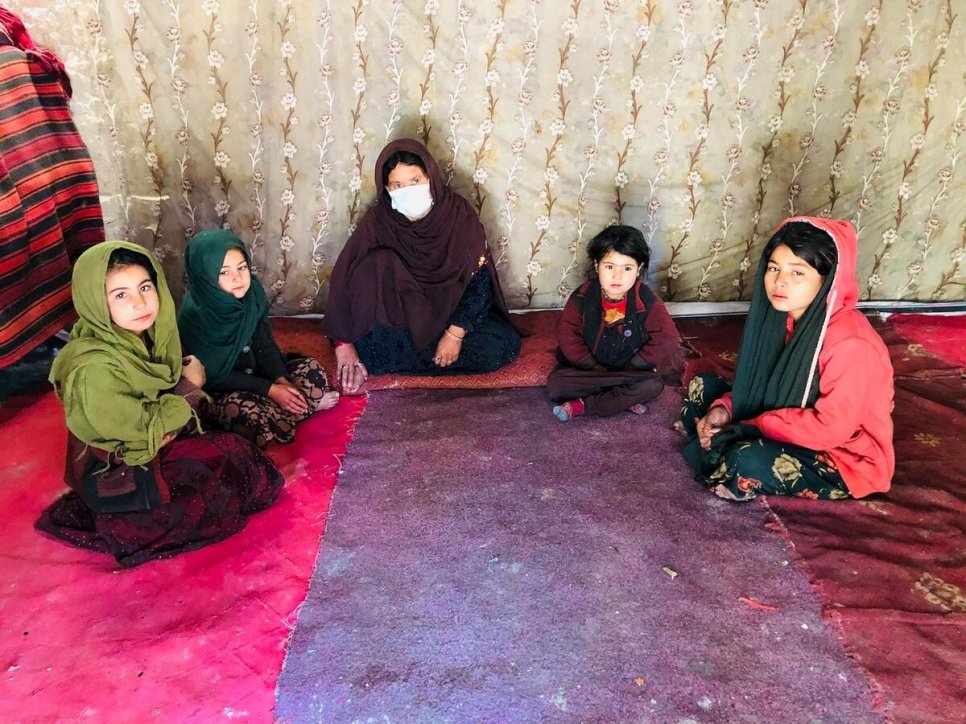
Chinar Gul with four of her five children. The family have been relying on food gifts from neighbours since the start of the pandemic. © UNHCR/Lima Haidari
“After that, we were in trouble,” said Chinar. “During the lockdown, we missed one or two meals a day. I was just giving my children water and telling them that I would give them food later.”
Now, Chinar’s 10-year-old son spends his days collecting rubbish they can burn to stay warm, while the family relies on gifts of food from their neighbours. When the neighbours have nothing to spare, “we sleep hungry at night,” Chinar said.
Even before COVID-19, decades of conflict, recurring natural disasters and a weak economy had been steadily eroding the ability of millions of Afghans to feed themselves. By early in the pandemic, the country was already facing one of the most severe food crises in the world, and by the end of the year, 16.9 million people – a staggering 42 per cent of Afghanistan’s population – were facing “crisis” or “emergency” levels of food insecurity. Nearly half of all children under five are estimated to be at risk of acute malnutrition this year.
In response, UNHCR and other humanitarian organizations committed to providing food and other life-saving support to 15.7 million needy Afghans in 2021.
Food ration cuts deepen hardships
Aid is also critical to help keep displaced people in Eastern Africa from going hungry, particularly at a time when COVID-19 lockdowns have seen income from small businesses and casual work dry up, but recent funding shortfalls have led to food ration cuts for over 3 million refugees in the region. UNHCR and the WFP have warned that the cuts – which have seen rations slashed by more than half in some countries – could lead to an increased incidence of malnutrition, anaemia and stunted child growth.
“The pandemic has been devastating for everyone, but for refugees even more so,” said Clementine Nkweta-Salami, UNHCR’s Regional Bureau Director Bureau for the East, Horn of Africa and the Great Lakes. “Unless more funds are made available, thousands of refugees – including children – will not have enough to eat.”
“We used to eat twice a day. Now we eat once.”
That is already the case for Vicky Comfort, a 17-year-old from South Sudan living in the Rhino Camp refugee settlement, in north-western Uganda. Her family of six have relied on food rations since fleeing home. But amid a US$77 million funding shortfall for operations in Uganda – which hosts the largest refugee population in Africa – the WFP was forced to cut food assistance to some 1.27 million refugees in February, by 40 per cent.
“We used to eat twice a day. Now we eat once,” said Vicky, adding that she has noted the effects that the family’s reduced food intake has had on her health. “I have lost weight and my immunity is low. I’m always falling sick because of poor feeding.”
Besides skipping or reducing meals, Nkweta-Salami of UNHCR said the food ration cuts were resulting in refugees resorting to various other “negative coping strategies”, including taking out high-interest loans, selling off belongings and sending children out to work.
“There is often a desperation and a feeling of no alternative,” she said.
Basirika Doro, a 26-year-old South Sudanese woman living in the Imvepi refugee settlement, also in north-western Uganda, said that the experience of hunger has led her family to rethink their decision to leave South Sudan.
“This always forces us to think about our home country and wonder if we had not fled to this camp, maybe life would be better,” she said.
Reporting by Abdul Basir Wafa in Kabul; Peter Eliru in Uganda’s Rhino Camp refugee settlement; Vincent Kasule in Uganda’s Imvepi refugee settlement.



